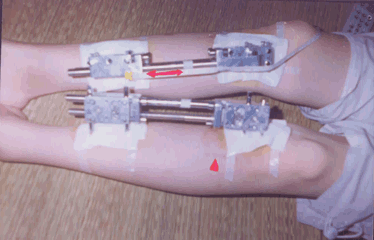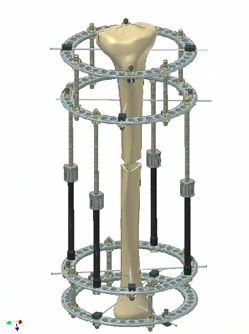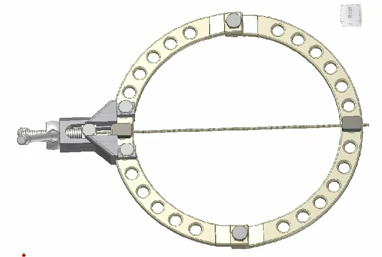[Note: This is the 2nd post written by my collaborator on this project. She is a very welcome addition and it shows in her research and writing that she is very dedicated to the cause. Thanks Nicki.]
BMPS and Growth
BMPS are most associated with BMPRs (Bone morphogenetic protein receptors). Defects in BMPS can lead to many skeletal disorders. Other names for BMPS are CDMPS (cartilage derived morphogenetic proteins) and GDFS (growth differentiation factors). The family of BMPs is comprised of at least 15 members, which are all part of the TGFβ superfamily. BMPs were originally identified as stimulators of bone formation but are now recognized as important regulators of growth, differentiation, and morphogenesis during embryology.
Within the developing limb cartilage elements, BMP2, -4, and -7 have been detected in the perichondrium, whereas BMP6 was found in prehypertrophic and hypertrophic chondrocytes.In addition, BMP7 was detected in chick sternal prehypertrophic and mice metatarsal proliferating chondrocytes.
The effects of BMPs are mediated by two type I receptors, BMPRIA and -IB, which heterodimerize with the type II receptor, BMPRII. The type I receptors are differentially localized in embryonic limbs; BMPRIB is detected in early mesenchymal condensations and is involved in early cartilage formation, whereas BMPRIA expression is confined to prehypertrophic chondrocytes.Constitutive active and/or dominant negative forms of BMPRIA and -IB revealed that the type IA receptor controls the pace of chondrocyte differentiation, whereas the type IB receptor is involved in cartilage formation and cell death (apoptosis).
Because various BMPs are expressed in chondrocytes, cartilage defects may be anticipated in BMP-related disorders in mice. Mice bred with homozygous null mutations in BMP2 and -4 are not compatible with life whereas other family members such as growth and differentiation factor 5 (GDF5) and BMP5 are important mediators of chondrocyte differentiation in mesenchymal condensations at various sites. In addition, mice carrying a targeted disruption of BMPRIB show defects in proliferation of prechondrogenic cells and chondrocyte differentiation in the phalangeal region.Additional BMPRIB/GDF5 and BMPRIB/BMP7 double knockout studies revealed that GDF5 is a ligand for BMPRIB and that in the absence of BMPRIB, BMP7 plays an essential role in appendicular skeletal development . In humans, only a few mutations in members of the TGFβ superfamily cause cartilage disorders. Genomic mutations in the human GDF5 gene have been shown to cause chondrodysplasia Grebe type, acromesomelic chondrodysplasia Hunter Thompson type, and brachydactyly type C, all of which are mainly characterized by defects of the limbs, with increasing severity toward the distal regions. Several mutations in the BMP antagonist noggin result in proximal symphalangism and multiple synostoses syndrome.
Recently, BMP6 was introduced as a possible mediator in the growth-restraining feedback loop involving Ihh and PTHrP. The fact that BMPRIA is expressed in the same region and that it has been shown to be critical for chondrocyte hypertrophy further strengthens an autocrine/paracrine role for BMP6 in prehypertrophic chondrocytes. Still, the BMP6 knockout mouse hardly has any phenotype, leaving little evidence for an important physiological role for BMP6 in chondrocyte differentiation. This was underscored by Minina et al. who elegantly showed that BMPs do not act as a secondary signal of Ihh to induce PTHrP expression or to delay the onset of hypertrophic differentiation. Despite this, they showed that normal chondrocyte proliferation requires parallel signaling of both Ihh and BMPs and that BMPs are capable of inhibiting chondrocyte differentiation independently of the Ihh/PTHrP pathway.
In another study, inhibition of chondrocyte differentiation by TGFβ was shown to be at least partly mediated by induction of PTHrP expression. In a second study by the same group, it was established that Shh, a functional substitute for Ihh, stimulates expression of TGFβ2 and -3 in mouse metatarsals and that TGFβ2 signaling is required for inhibition of differentiation and regulation of PTHrP expression by Shh. They concluded that TGFβ2 acts as a signal relay between Ihh and PTHrP in the regulation of chondrocyte differentiation . These data imply that the BMPs/TGFβ and their receptors act as a signaling system, both dependently and independently of the Ihh/PTHrP feedback loop, at different levels during embryonic bone formation.
Understanding BMPS
The roles of BMPs in embryonic development and cellular functions in postnatal and adult animals have been extensively studied in recent years. Signal transduction studies have revealed that Smad1, 5 and 8 are the immediate downstream molecules of BMP receptors and play a central role in BMP signal transduction. Studies from transgenic and knockout mice and from animals and humans with naturally occurring mutations in BMPs and related genes have shown that BMP signaling plays critical roles in heart, neural and cartilage development. BMPs also play an important role in postnatal bone formation. BMP activities are regulated at different molecular levels. Preclinical and clinical studies have shown that BMP-2 can be utilized in various therapeutic interventions such as bone defects, non-union fractures, spinal fusion, osteoporosis and root canal surgery. Tissue-specific knockout of a specific BMP ligand, a subtype of BMP receptors or a specific signaling molecule is required to further determine the specific role of a BMP ligand, receptor or signaling molecule in a particular tissue. BMPs are members of the TGFbeta superfamily. The activity of BMPs was first identified in the 1960s. “Bone formation by autoinduction”. but the proteins responsible for bone induction remained unknown until the purification and sequence of bovine BMP-3 (osteogenin) and cloning of human BMP-2 and 4 in the late “Novel regulators of bone formation: molecular clones and activities”. “Purification and partial amino acid sequence of osteogenin, a protein initiating bone differentiation”. “The bone morphogenetic protein family and osteogenesis”.To date, around 20 BMP family members have been identified and characterized. BMPs signal through serine/threonine kinase receptors, composed of type I and II subtypes. Three type I receptors have been shown to bind BMP ligands, type IA and IB BMP receptors (BMPR-IA or ALK-3 and BMPR-IB or ALK-6) and type IA activin receptor.”Characterization and cloning of a receptor for BMP-2 and BMP-4 from NIH 3T3 cells”.”Identification of type I receptors for osteogenic protein-1 and bone morphogenetic protein-4″.”Specific activation of Smad1 signaling pathways by the BMP7 type I receptor, ALK2″. Three type II receptors for BMPs have also been identified and they are type II BMP receptor (BMPR-II) and type II and IIB activin receptors. “Osteogenic protein-1 binds to activin type II receptors and induces certain activin-like effects”. “Cloning and characterization of a human type II receptor for bone morphogenetic proteins”. “Cloning of a novel type II serine/threonine kinase receptor through interaction with the type I transforming growth factor-beta receptor”. Whereas BMPR-IA, IB and II are specific to BMPs, ActR-IA, II and IIB are also signaling receptors for activins. These receptors are expressed differentially in various tissues. Type I and II BMP receptors are both indispensable for signal transduction. After ligand binding they form a heterotetrameric-activated receptor complex consisting of two pairs of a type I and II receptor complex.”From mono- to oligo-Smads: the heart of the matter in TGFbeta signal transduction”.The type I BMP receptor substrates include a protein family, the Smad proteins, that play a central role in relaying the BMP signal from the receptor to target genes in the nucleus. Smad1, 5 and 8 are phosphorylated by BMP receptors in a ligand-dependent manner. “MADR1, a MAD-related protein that functions in BMP2 signaling pathways”, “Smad5 and DPC4 are key molecules in mediating BMP-2-induced osteoblastic differentiation of the pluripotent mesenchymal precursor cell line. After release from the receptor, the phosphorylated Smad proteins associate with the related protein Smad4, which acts as a shared partner. This complex translocates into the nucleus and participates in gene transcription with other transcription factors. A significant advancement about the understanding of in vivo functions of BMP ligands, receptors and signaling molecules has been achieved in recent years. BMP signals are mediated by type I and II BMP receptors and their downstream molecules Smad1, 5 and 8. Phosphorylated Smad1, 5 and 8 proteins form a complex with Smad4 and then are translocated into the nucleus where they interact with other transcription factors, such as Runx2 in osteoblasts. BMP signaling is regulated at different molecular levels: Noggin and other cystine knot-containing BMP antagonists bind with BMP-2, 4 and 7 and block BMP signaling. Over-expression of noggin in mature osteoblasts causes osteoporosis in mice. Smad6 binds type I BMP receptor and prevents Smad1, 5 and 8 to be activated. Over-expression of Smad6 in chondrocytes causes delays in chondrocyte differentiation and maturation. Tob interacts specifically with BMP activated Smad proteins and inhibits BMP signaling. In Tob null mutant mice, BMP signaling is enhanced and bone formation is increased. Smurf1 is a Hect domain E3 ubiquitin ligase. It interacts with Smad1 and 5 and mediates the degradation of these Smad proteins. Smurf1 also recognizes bone-specific transcription factor Runx2 and mediates Runx2 degradation. Smurf1 also forms a complex with Smad6, is exported from the nucleus and targeted to the type I BMP receptors for their degradation. Over-expression of Smurf1 in osteoblasts inhibits postnatal bone formation in mice .
BMP-2 And Longitudinal Growth
Abstract
Bone morphogenetic proteins (BMPs) regulate embryonic skeletal development. We hypothesized that BMP-2, which is expressed in the growth plate, also regulates growth plate chondrogenesis and longitudinal bone growth. To test this hypothesis, fetal rat metatarsal bones were cultured for 3 days in the presence of recombinant human BMP-2. The addition of BMP-2 caused a concentration-dependent acceleration of metatarsal longitudinal growth. As the rate of longitudinal bone growth depends primarily on the rate of growth plate chondrogenesis, we studied each of its three major components. BMP-2 stimulated chondrocyte proliferation in the epiphyseal zone of the growth plate, as assessed by [3H]thymidine incorporation. BMP-2 also caused an increase in chondrocyte hypertrophy, as assessed by quantitative histology and enzyme histochemistry. A stimulatory effect on cartilage matrix synthesis, assessed by 35SO4 incorporation into glycosaminoglycans, was produced only by the highest concentration of BMP-2. These BMP-2-mediated stimulatory effects were reversed by recombinant human Noggin, a glycoprotein that blocks BMP-2 action. In the absence of exogenous BMP-2, Noggin inhibited metatarsal longitudinal growth, chondrocyte proliferation, and chondrocyte hypertrophy, which suggests that endogenous BMPs stimulate longitudinal bone growth and chondrogenesis. We conclude that BMP-2 accelerates longitudinal bone growth by stimulating growth plate chondrocyte proliferation and chondrocyte hypertrophy.
BMPS AND IHH /PHTrP INTERACTION
During endochondral ossification, two secreted signals, Indian hedgehog (Ihh) and parathyroid hormone-related protein (PTHrP), have been shown to form a negative feedback loop regulating the onset of hypertrophic differentiation of chondrocytes. Bone morphogenetic proteins (BMPs), another family of secreted factors regulating bone formation, have been implicated aspotential interactors of the Ihh/PTHrP feedback loop.To analyze the relationship between the two signaling pathways, we used an organ culture system for limb explants of mouse and chick embryos. We manipulatedchondrocyte differentiation by supplementing these cultures either with BMP2, PTHrP and Sonic hedgehog as activators or with Noggin and cyclopamine as inhibitors of the BMP and Ihh/PTHrP signaling systems. Overexpression of Ihh in the cartilage elements of transgenic mice results in an upregulation of PTHrP expression and a delayed onset of hypertrophic differentiation. Noggin treatment of limbs from these mice did not antagonize the effects of Ihh overexpression. Conversely, the promotion of chondrocyte maturation induced by cyclopamine, which blocks Ihh signaling, could not be rescued with BMP2. Thus BMP signaling does not act as a secondary signal of Ihh to induce PTHrP expressionor to delay the onset of hypertrophic differentiation. Similar results were obtained using cultures of chick limbs. We further investigated the role of BMP signaling in regulating proliferation and hypertrophic differentiation of chondrocytes and identified three functions of BMP signaling in this process. First we found that maintaining a normal proliferation rate requires BMP and Ihh signaling acting in parallel. We further identified a role for BMP signaling in modulating the expression of Ihh. Finally, the application of Noggin to mouse limb explants resulted in advanced differentiation of terminally hypertrophic cells, implicating BMP signaling in delaying the process of hypertrophic differentiation itself. This role of BMP signaling is independent of the Ihh/PTHrP pathway.
We have identified several Ihh-independent functions of BMP signaling. One of these is to regulate the process of terminal hypertrophic differentiation. Blocking of BMP signaling by Noggin results in an increased number of Osp-expressing, terminal hypertrophic cells. By contrast, cyclopamine treatment, which leads to an advanced onset of hypertrophicdifferentiation, does not increase Osp expression. Double treatment experiments support the idea that BMP and
Analysis of mutations in single Bmp genes has not given significant insight into their role during skeletal differentiation. Targeted disruption of either Bmp2 or Bmp4 leads to early embryonic lethality (Winnier et al., 1995; Zhang and Bradley, 1996), whereas mutations in Bmp5, Bmp6 or Bmp7 only display mild skeletal phenotypes (Dudley et al., 1995; King et al., 1994; Kingsley et al., 1992; Luo et al., 1995; Solloway et al., 1998), indicating a highly redundantrole of Bmp genes in regulating bone development. In this study we have attempted to analyze the role of BMP signaling during chondrocyte maturation without differentiating between individual Bmp genes. As BMP proteins can substitute for each other in experimental systems, we have used BMP2 protein to mimic the role of several BMPs. Similarly, Noggin has been shown to inhibit signaling of various members of the BMP family (Zimmerman et al., 1996; Kawabata et al., 1998). Several Bmp genes are expressed in specific regions of the developing cartilage elements and might thus be important for different aspects of chondrocyte differentiation during normal development. Bmp7 is expressed in the proliferating chondrocytes distal to Ihh (Haaijman et al., 2000; Solloway et al., 1998) and may be responsible for regulating chondrocyte proliferation and Ihh expression. Other Bmps, including Bmp2, Bmp3, Bmp4 and Bmp7, are expressed in the perichondrium/ periosteum (Pathi et al., 1999; Zou et al., 1997; Daluiski et al.2001; Haaijman et al., 2000) .
Conclusion
BMPs are the only molecules so far discovered capable of independently inducing endochondral ossification in vivo. TGF-b1 and TGF-b2 enhance the osteoinductive properties of BMPs; however, injection of TGF-bs on their own leads to extensive fibrous tissue formation only (Bentz, Armstrong & Seyedin, 1987). The mechanism of action of the BMPs has yet to be defined. However, the availability of recombinant forms has led to much work on their biological activity in vivo and in vitro. Recombinant forms of BMP2 and BMP4 induce ectopic bone formation, and BMP2 will heal cortical bone defects by an endochondral process (Hammonds et al., 1991; Wang, Rosen & Cordes, 1990; Yasko et al., 1992). BMP2 stimulates the growth and differentiation of growth plate chondrocytes in vitro, and results in the development of the osteoblast phenotype in a rat pluripotential cell line (Hiraki et al., 1991). Osteoblasts have been shown to have high affinity binding proteins for BMP on the cell surface (Paralkar, Hammonds & Reddi, 1991).
Indirect lines of evidence demonstrate that BMPs have a critical role in bone development. Firstly, the protein encoded by the decapentaplegic locus (dpp) in Drosophila is a member of the TGF-b family member with 75% sequence homology to BMP2, suggesting a common ancestral gene. Developmental anomalies produced by mutations of the dpp gene are similar to patterns of disease expression in fibrodysplasia ossificans progressive, a developmental disorder characterised by deformations of the hands and feet and heterotopic chondrogenesis (Kaplan, Tabas & Zasloff, 1990). In addition, the chromosomal locations of the BMP genes overlap with the loci for several disorders of cartilage and bone formation (Tabas et al., 1991). More direct evidence is provided by a recent study which demonstrated that BMP2, together with fibroblast growth factor-4, is important in regulating limb growth in the mouse embryo (Niswander & Martin, 1993).
Me:: As you can see the group for Bone Morphogenetic Proteins (BMPs) is one of the most critical elements involved in the endochondral growth process. If I was to guess with the knowledge I have right now, I would move away from looking for way to increase GH release in the body but focus more on finding ways to get specifically the 20 discovered BMPs analyzed. The best way to start on that is to start on looking into BMP2, BMP5 and BMP7. My hypothesis is that the BMPs are the proteins that allow for the growth plates to run so efficiently for the chondrocytes to move form the proliferative layer to the ossification layer since there are two different processes going on right next to each other.
The parathyroid hormone-related protein (PTHrP) group is another possibility we need to study on because I have at least 3 papers so far showing that the Thyroid hormone proteins have been used as a template to create similar synthetic compounds used for bone growth. The other area to look into as well is the BMP2 inhibiting Noggin glycoprotein.


 t
t –
–
 k
k n
n n)
n)




